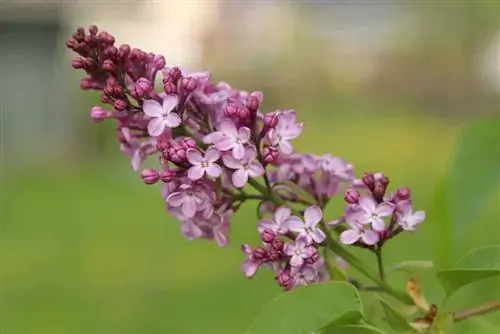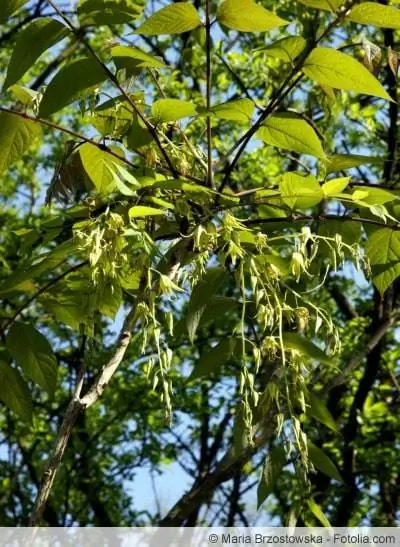- Author admin [email protected].
- Public 2023-12-17 03:39.
- Last modified 2025-01-24 12:45.
Lilac trees or bushes can be found in many home gardens. In summer they delight viewers in different shades of purple or white, as there are up to 30 different species. All of these easy-care trees exude an intoxicating scent. Lilac bushes actually bloom most beautifully when they are allowed to grow wild. But it is not always possible to do without pruning. If you prune the lilac tree correctly, it will continue to bloom profusely.
Pruning of different species
Even though there are up to 30 different types of lilac bushes that display their flowers in a wide variety of colors, the steps required for successful pruning are the same for all of them. Most garden enthusiasts in this latitude enjoy the common lilac, also called Syringa vulgaris, which blooms in white or purple. But there are also other types from white to light yellow to light or dark purple. But no matter which lilac is in your own garden, it actually doesn't need to be cut and reveals all its beauty when it grows wild. But the home garden doesn't always offer enough space and then it has to be cut back. But this can also be done without preventing the lilac bush from blooming.
Tip:
Lilac is very suitable as a cut flower in a vase. To do this, ideally in the morning cut off as many stems with flowers at an angle as desired. Leaves are removed for the vase so that they do not waste unnecessary energy and the flowers remain beautiful for longer.
Ideal time
The lilac bush in your own garden can also be pruned annually if it is not allowed to grow too large due to lack of space. The best time to do this is:
- in late spring or early summer right after flowering
- then it is already warm enough that the interfaces can dry quickly
- otherwise there could be a risk of fungal infestation
- If a lilac needs to be cut radically due to aging, then this can be done all year round
Suitable tool
Depending on which cut is to be made, the right tool is also required. It is important to ensure that it is always cleaned and disinfected before work. This prevents germs or bacteria from entering the plant through the interfaces, which could harm it. For this purpose, appropriate disinfectants from well-stocked retailers or pure alcohol from the pharmacy can be used. The following tools are required:
- sharp scissors to cut the flowers and soft shoots
- sharp saw for when you have to cut into hard wood
- a ladder if the tree or bush has grown very tall
Tip:
Be sure to use sharp tools when pruning the lilac bush! If the tool is not sharp, injuries can occur at the cut area. The shoots and old branches must always be cut smoothly and not frayed, otherwise germs and bacteria can penetrate the cut more quickly, as it cannot heal well.
Pruning after flowering

Annual pruning after flowering is advantageous because the lilac bush looks attractive again after cutting. However, this type of lilac tree pruning has nothing to do with greater flowering next year; it is purely a visual matter. Even if you don't want to find many new lilac plants in your garden next year, cut off the withered flowers, otherwise the seeds that form can be spread by the wind throughout the garden and even to your neighbors. This cut is therefore done as follows:
- Remove the dried inflorescences about a week after they have faded
- here the dried flowers above the leaves are removed directly, the shoots remain standing
- Dried, old and dead shoots can also be removed directly at this time
Tip:
If the old flowers and old, withered shoots are removed every year, the hobby gardener otherwise has little work to do with the lilac. In this way it gets a nice shape and the growth can be kept within limits. A small annual cut requires less work than if a lilac that has become too large due to wild growth has to be cut altogether.
Pruning to reduce size
If the lilac bush has become too large in its location, it must be cut back so that other plants in its vicinity are not hindered in their growth. Even if the branches are already growing towards the neighbor or onto the street, the lilac bush must be pruned back. To do this, proceed as follows:
- Lilac only blooms on two-year-old shoots
- therefore the flowers may be sparser after pruning
- However, this can also be prevented by the ideal cut
- Lilac is only partially cut every year
- For this purpose, one- or two-year-old shoots are left on the bush
- older wood can be removed
- always cut directly at a branch fork
- don't leave stubs
Pruning when aging
Lilac bushes and trees can live to a ripe old age. But it can happen that an old bush no longer shows any flowers. In such a case, the lilac can be saved by a radical cut:
- the lilac is ideally cut back to about one meter in the summer when it is warm enough
- this pruning can also be done all year round
- so new shoots can form from below next spring
- don't cut these back in the next few years
Tip:
After pruning if the lilac is old, the hobby gardener needs a lot of patience because it can take up to two years until the bush has grown lushly again. But it's definitely worth not removing the lilacs from the garden entirely just because they're old.
Conclusion
A lilac bush in the garden enriches the entire environment with its intoxicating scent and graceful flowers. The easy-care lilac is particularly suitable for hobby gardeners with little time. Because a cut only needs to be made if it gets too big. Otherwise, the lilac tree delights with lush blooms every year, even without pruning. Wild-growing shrubs in particular have the most flowers. However, if you spend a little time pruning in the early summer months every year, you can have a beautifully shaped and flowering lilac bush or tree.
What you should know in brief
Procedure

Since lilacs are delicate trees, it is important that you use a very sharp pruning tool. If the blade is too dull, it would damage the bark, which in turn would provide an ideal breeding ground for germs and pathogens. It would also be quite practical if you had pruning shears on hand. This would make pruning back the stronger branches a lot easier. And this is how you carry out the pruning:
- Remove all diseased, dead and old shoots.
- Then cut off all wilted flower shoots. This should leave about three eyes behind.
- Don't cut back too much, otherwise you might not have any flowers in the coming season.
- When pruning, pay attention to an even growth pattern so that you maintain the overall appearance of the lilac and do not mutilate it.
- Also cut all the shoots that are on the trunk of the lilac.
Cutting circumference
- Since lilacs often grow very tall and wide, they sometimes have to be cut a little more radically for reasons of space.
- When pruning, only leave branches up to one meter high.
- However, after such a cut, you should not be surprised, because the lilac will not produce flowers for at least a season.
- Such a radical cut should therefore only be carried out if it is absolutely necessary.
- Before you plant a lilac, make sure you have enough space for it.
Tip:
You can also use lilacs as hedge plants. Please note from the outset that the individual plants are spaced enough apart so that radical pruning is not necessary. Because only a blooming lilac brings radiant shine and a delicate scent to your garden.
Putting together a lilac bouquet
- Lilac is ideal for the vase. It's best to cut this in the early hours of the morning.
- Remove the leaves and cut the stems at a slight angle so you can enjoy your lilac bouquet for longer.
- If you often cut off a bouquet of lilacs, then you have less to do when cutting them back.






